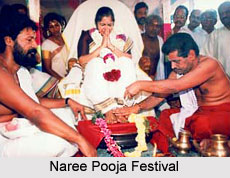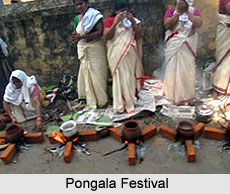 Chakkulathu Kavu Temple, dedicated to Goddess Durga is located in the border of Pathanamthitta District and Alappuzha District. It is 12 Km westward from the town of Thiruvalla in Neerattupuram Junction. The famous Pampa River and Manimala River flow on either side of the temple. Chakkulathu Kavu Temple celebrates many festivals on a grand scale during which the temple is decorated with lights and flowers. Some of the festivals celebrated by the temple are:
Chakkulathu Kavu Temple, dedicated to Goddess Durga is located in the border of Pathanamthitta District and Alappuzha District. It is 12 Km westward from the town of Thiruvalla in Neerattupuram Junction. The famous Pampa River and Manimala River flow on either side of the temple. Chakkulathu Kavu Temple celebrates many festivals on a grand scale during which the temple is decorated with lights and flowers. Some of the festivals celebrated by the temple are:
Pongala
This is one of the most renowned festivals that is celebrated in the temple during the month of `Vrischikam` (November/December). This festival is mainly attended by lakhs of women devotees gather around the temple as early as even one week before the function. The devotees bring rice, coconut and jaggery along with round earthen ports for cooking. The Chief Priest of the temple lights the main hearth from the divine fire inside the sanctum sanctorum. This fire is exchanged from one over to another.
Naree Pooja
This festival is celebrated in honour of women. It reminds one the respect and honour a woman holds in society. The temple celebrates the festival on a grand scale. Women are seated on specially arranged seats. Their feet are respectfully washed. This is an indirect expression of the divine Mother. Thousands of women are invited to take part in this function. Innumerable devotees stand as witness to this rare ritual that proclaims the potency and glory of the divine Mother.
The First Friday
 The temple celebrates the first Friday of every Malayalam month. The festival marks a spiritually significance day for the Temple. On this day devotees observe rigorous fasting. They reach the temple and worship of the deity on this day. Mant rituals are also conducted. The small idol of the God which is usually placed inside the sanctum sanctorum beside the main idol is carried in procession. It is later brought to the specially arranged place for prayer.
The temple celebrates the first Friday of every Malayalam month. The festival marks a spiritually significance day for the Temple. On this day devotees observe rigorous fasting. They reach the temple and worship of the deity on this day. Mant rituals are also conducted. The small idol of the God which is usually placed inside the sanctum sanctorum beside the main idol is carried in procession. It is later brought to the specially arranged place for prayer.
Thrikkarthika
The festival of Thrikkarthika is celebrated on the malayalam month of Vrischika. This day became famous after a surprising incident that took place in the year 1851. Once, few devotees had gathered in front of the temple for the `Nirmalya Darsanam.` They were all amazed to see rings of perfumed smoke all around the temple. Rare glow of light could be seen in front of the temple. However, no one could understand what was happening. As the priest opened the temple, everyone was spell bound. All the lamps inside were alive with a unique touch of brilliance. The idol of the Goddess decked with ornaments and bathed in Kumkum seemed extra ordinarily large.
On the Divyabhishekam the idol is coated with oil. Later milk, tender coconut, rose water, tamarind and Kumkum are poured over the idol. The main doors are closed for Deeparadhana. The idol is beautifully decorated. Later the doors are opened for others to have a sight of the Deeparadhana. It is believed that anyone who witnesses this ritual gets rid from all evils and bondages of life.
A tall coconut tree is erected for this purpose. Many items like plantain, straw and similar items are tied to it. It is regarded as a symbol of all evils. At dawn the Goddess is invoked with all devotion and is seated facing the east direction in front of the temple. The tree is now put to fire. Wild flames seem to reach the sky and then gradually subside. It is believed that all evils that exist have been eradicated after putting them to fire. Immediately after the burning gentle flames are seen coming alive from the small clay dishes arranged all around. It is known as Lakhadeepam. People who gather there kindle the small clay dishes which contain oil and cotton thread. The sight of the temple being illuminated by lights is worth watching. This ritual signifies that goodness ultimately dominates all evils. The yellow flames dispel ignorance from the human minds and equip them with real knowledge. The goddess is then invoked back to the temple. Deeparadhan is then performed.
Kalamezhuthu
In this the divine of the goddess is drawn in an elaborate size using differently coloured powders. The powers of Goddess are invoked and the Devi`s presence is obtained. Poojas are performed and Devi is worshipped. This ritual carries the singing of many hymns in praise of the Goddess.











